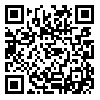Volume 11, Issue 4 (2020)
JMBS 2020, 11(4): 29-42 |
Back to browse issues page
Download citation:
BibTeX | RIS | EndNote | Medlars | ProCite | Reference Manager | RefWorks
Send citation to:



BibTeX | RIS | EndNote | Medlars | ProCite | Reference Manager | RefWorks
Send citation to:
Tohidlou M, Sadeghi Mohammadi S, Vaezi Z, Taghdir M, Naderi-Manesh H. Synthesis of nanoliposomes containing green tea Catechin and doxorubicin to evaluate its toxicity on breast cancer cells. JMBS 2020; 11 (4) :29-42
URL: http://biot.modares.ac.ir/article-22-39928-en.html
URL: http://biot.modares.ac.ir/article-22-39928-en.html
Mohammad Tohidlou1  , Sanam Sadeghi Mohammadi2
, Sanam Sadeghi Mohammadi2  , Zahra Vaezi1
, Zahra Vaezi1  , Majid Taghdir3
, Majid Taghdir3  , Hossein Naderi-Manesh *
, Hossein Naderi-Manesh *  4
4
 , Sanam Sadeghi Mohammadi2
, Sanam Sadeghi Mohammadi2  , Zahra Vaezi1
, Zahra Vaezi1  , Majid Taghdir3
, Majid Taghdir3  , Hossein Naderi-Manesh *
, Hossein Naderi-Manesh *  4
4
1- Biophysics Department, Biological Sciences Faculty, Tarbiat Modares University, Tehran, Iran
2- Nanobiotechnology Department, Biological Sciences Faculty, Tarbiat Modares University, Tehran, Iran
3- Biophysics Department, Biological Sciences Faculty, Tarbiat Modares University, Tehran, Iran, Department, Biological Sciences Faculty, Tarbiat Modares University, Tehran, Iran
4- Biophysics-Nanobiotechnology Department, Biological Sciences Faculty, Tarbiat Modares University, Tehran, Iran , naderman@modares.ac.ir
2- Nanobiotechnology Department, Biological Sciences Faculty, Tarbiat Modares University, Tehran, Iran
3- Biophysics Department, Biological Sciences Faculty, Tarbiat Modares University, Tehran, Iran, Department, Biological Sciences Faculty, Tarbiat Modares University, Tehran, Iran
4- Biophysics-Nanobiotechnology Department, Biological Sciences Faculty, Tarbiat Modares University, Tehran, Iran , naderman@modares.ac.ir
Abstract: (1289 Views)
Chemotherapy is one of the most effective and common treatments for cancer. Multi-drug resistance and drug side effects are one of the major obstacles to successful chemotherapy. To address these limitations and achieve better drug efficacy, nanosystem-based combination therapy offers a promising approach. This study aimed to synthesize, characterize, and investigate the synergistic effect of nanoliposomes loaded with doxorubicin and epigallocatechin-3-gallate (EGCG) on MCF-7 breast cancer cell lines. In the present study, nanoliposomes were prepared by passive loading and thin-film hydration. The characterization of nanoliposomes such as size distribution, zeta potential, the loading rate, drug release profile, and toxicity were measured. The mean diameter of nanoliposomes was 82.5 nm, their surface charge was -24.2 mV and drug loading was about 80%. The interaction of doxorubicin and EGCG with nanoliposomes was mediated by electrostatic and van der Waals bonds and EGCG has a deceasing effect on the doxorubicin release profile but the observed differences are not significant. The toxicity and viability data indicate that the simultaneous use of these two drugs increased the toxicity of the cells. Nanoliposomes containing doxorubicin were not able to reduce viability to below 50% in monotherapy with 5×10-3 μM. While, the amount of viability dramatically reduced to below 50%, in combination with EGCG, resulting as combination chemotherapy. Consequently, the concomitant administration of EGCG with doxorubicin may be a suitable candidate for chemotherapy.
Article Type: Original Research |
Subject:
Nanotechnology
Received: 2020/01/15 | Accepted: 2020/09/30 | Published: 2020/11/30
Received: 2020/01/15 | Accepted: 2020/09/30 | Published: 2020/11/30
Send email to the article author
| Rights and permissions | |
 |
This work is licensed under a Creative Commons Attribution-NonCommercial 4.0 International License. |







